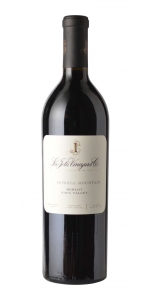Wine from La Jota

La Jota Vineyard Co. was founded in 1898 by Frederick Hess, an immigrant from Switzerland, who established a German-language newspaper in San Francisco. No doubt influenced by other European immigrants involved in California's nascent wine industry, Hess purchased 327 acres of a Mexican land grant—Rancho La Jota—on Howell Mountain to plant vineyards. He built the stone winery from volcanic ash rock quarried on the property; his first fermentation tanks also came from the estate, from a stand of nearby coastal redwoods.
The rocky, shallow soils, the abundance of wind and fog, and the remoteness of Howell Mountain terroir were reminiscent of Europe where some of the best wines in the world were being produced. Hess, along with other early pioneers, believed that Napa Valley could achieve the same distinction – and they were right. At the 1900 Paris Exposition, only two years after the winery's construction, La Jota garnered international recognition after Hess won a bronze medal for his "Blanco."
Prohibition effectively ended wine production in the United States and the market for Howell Mountain's superior wines collapsed. Although Prohibition ended in 1933, the damage was already done. A few Howell Mountain wineries attempted to start up again, but none succeeded. Ultimately the wineries were left empty and the region became home to numerous "ghost" wineries. A half-century went by, and in 1974, former oilman Bill Smith acquired the "ghost" La Jota Vineyard Co. and planted vines on the estate. Eight years later, in 1982, the revived La Jota winery was officially bonded. In 2005, California wine pioneer Jess Jackson and his wife Barbara Banke purchased La Jota.
Today, the winery proudly carries on the century-old La Jota Vineyard Co. winemaking tradition, producing small lots of mountain Cabernet Sauvignon, Merlot, Cabernet Franc, and Chardonnay.
There are 28 acres planted across three estate vineyards, each with its own distinct personality. The Hill vineyard is the highest, sunny and steep. The Meadow vineyard is the largest, and the Winery Block vineyard sits next to the original 19th century stone winery. The Winery Block is planted with St. George rootstock, and comprised of unique, phylloxera-resistant Cabernet Franc vines that date back over 40 years.
La Jota Howell Mountain Cabernet Franc is made from 100% Cabernet Franc.
The 2019 Cabernet Franc opens with aromas of cassis and graphite when poured in the glass. The firm tannins set the stage on the palate melded with rich flavors of boysenberry and pain de grille with a silky mouthfeel and lingering finish.
Review:
Savory in black pepper, smoked meat and cigar box, this wine is high-toned aromatically, with lovely hints of violet and dried herb, sage and bay leaf. Mountain-sturdy tannins give it structure, power and room to age, with lasting acidity to keep it fresh. Enjoy best from 2029–2039
.-Wine Enthusiast 95 Points
La Jota Vineyard Merlot Howell Mountain is made from 100 percent Merlot.
Sourced from vineyards with pedigrees dating back to the 1800s, this wine continues to carry the torch of Howell Mountain’s greatness. e aromatics are lifted with plum, huckleberry and minerality leading the way. Bittersweet chocolate and dried herbs add the punctuation to an incredibly long balanced finish.
-Wine Spectator 95 Points
In general, 2018 was a great vintage for this variety, and the deep purple-hued 2018 Merlot is stunning stuff. Lots of cassis, candied violets, scorched earth, and graphite notes give way to a medium to full-bodied, beautifully textured, elegant 2018 with polished tannins, no hard edges, and a great finish. It’s going to evolve for 15 years or more.
- Jeb Dunnuck 95 Points
- James Suckling 95 Points
- back
Selected Options
Wineries
Categories
Pricing
Countries
Regions
Grape Types
Wineries
Organic/Free Shipping
La Despensa Boutique Sangiovese is made from 100 percent Sangiovese.
There's really very little Sangiovese in Chile. It was an educated gamble to plant this variety in La Despensa little corner of Colchagua and the team is thrilled with the results.
This Sangiovese is a fresh and fruity take on a classic Italian variety, but with the typical savoury notes of tomato and cherry. Perfect for early drinking, but will improve for many years to come.
Salvadori Chianti Riserva DOCG 2017 is made from Sangiovese 90% , Merlot 10






